Mississippi Triangle, a sky mystery - OPOD
Mississippi Triangle: A Mysterious Sky Phenomenon
Have you ever witnessed a peculiar sky phenomenon that left you puzzled? On May 27, 2015, the Planche family experienced just that while driving eastwards on Interstate 10. As the dusk approached, they spotted a strange red triangle in the sky. These intriguing images, captured by Andrew Planche on his iPhone, spanned 15 seconds and immediately caught the attention of atmospheric optics enthusiasts.
In an attempt to unravel the mystery behind this phenomenon, three experts collaborated to analyze the images: Les Cowley from OPOD (Optics Picture of the Day), Raymond Lee from the US Naval Academy and co-author of "Rainbow Bridge," and Gavin Pretor-Pinney, the founder of The Cloud Appreciation Society. Together, they embarked on an investigation to provide an explanation for this enigmatic sight.
The first step in understanding any sky sighting is to calculate the position of the sun. By carefully examining the image times and cross-referencing them with the vehicle's GPS location, as well as comparing an image with Google Earth, the researchers determined that the sun was low on the horizon, a mere 0.2° high in the WNW (west-northwest). The red glow of the sunset was visible in the car's side mirror, while the sunset rays illuminated the highway signs with a captivating red light.
One possible explanation for the triangular shape was that it resembled a fragment of a rainbow. The left-hand side of the triangle appeared to have a curved shape, with a strong red edge and weak greens on its right side. Moreover, it extended weakly both below and above the triangle. The positioning of this rainbow fragment relative to the sun was also correct. As sunset rainbows can exhibit a highly reddened appearance and illuminate the sky inside the bow, this finding added weight to the hypothesis that it was indeed a rainbow fragment.
However, a closer examination of the images revealed another intriguing element: a red line parallel to the horizon extending well beyond the triangle on the left side. This line was likely a cloud edge that was illuminated by the low sun. It brightened inside the rainbow, further supporting the notion that this phenomenon was a result of natural atmospheric optics.
While some aspects of the sighting seemed to align with known atmospheric phenomena, there was one element that posed a challenge: side C of the triangle. Its angle to the rainbow's rim did not match what would be expected if it were a spoke or ray of the rainbow. Reflection bows from water were also ruled out, as they do not form at such an angle when the sun is near the horizon.
The breakthrough came when an additional image became available, showing several slanting rain sheets lit up by the low sun along the horizon. This finding strongly suggested that the streak on side C could be a result of falling rain, either in the form of virga (rain that evaporates before reaching the ground) or rain that had just reached the ground. The raindrops within the rainbow's edge reflected the sun's red light, causing them to appear bright. This phenomenon explained why side C of the triangle appeared so vivid. Another rain streak was observed as a weaker line above side C.
To confirm their hypothesis, the researchers gathered additional data on wind speed and direction from a local weather station and obtained weather balloon measurements taken around the time of the photos. Their findings revealed that there was indeed rain and that the wind was blowing in the right direction. Rain sheets tilt due to the slowing of wind close to the ground, causing falling raindrops to be dragged back against the wind direction as they descend. The angle of the rain sheets was estimated to be 40° based on an estimated raindrop diameter of 0.5mm, which matched the tilt of side C and the other streaks.
In conclusion, the captivating Mississippi Triangle in the sky was the result of four separate but natural atmospheric effects coming together coincidentally. These effects included a reddened sunset sun, a fragment of a rainbow, an illuminated horizontal cloud bank, and a rain sheet shining with rainbow rays. Each of these elements contributed to the formation of the eerie triangle observed by the Planche family. Once the various phenomena were analyzed and understood, the mystery was solved, reminding us that even seemingly magical occurrences can be explained through the fascinating science of atmospheric optics.
So, the next time you encounter a puzzling sky phenomenon, take a moment to observe and explore its possible explanations. Who knows what wonders you might uncover in the ever-changing canvas of the atmosphere above us?
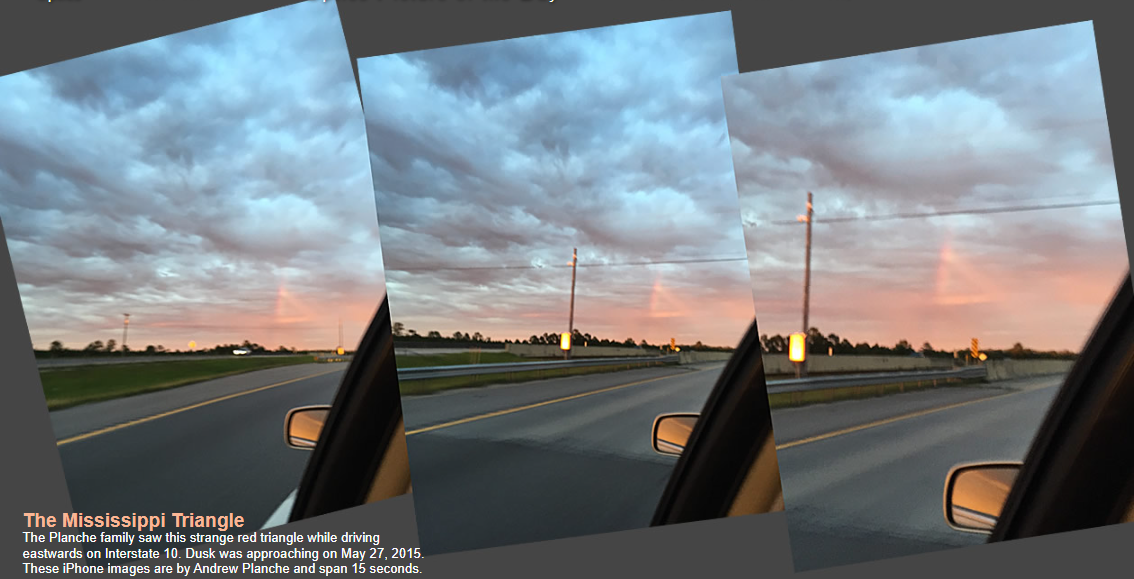
The Mississippi Triangle
The Planche family saw this strange red triangle while driving eastwards on Interstate 10. Dusk was approaching on May 27, 2015. These iPhone images are by Andrew Planche and span 15 seconds.
All images ©Andrew Planche, shown with permissionThe triangle enhanced.
The sighting was both fascinating and enigmatic. Three of us collaborated to get an explanation – Les Cowley (OPOD), Raymond Lee (US Naval Academy & co-author of Rainbow Bridge) and Gavin Pretor-Pinney (Author & founder of The Cloud Appreciation Society).
The Sun
The first act in an investigation of a sky sighting is to calculate the sun�s position. Always keep an accurate camera clock and know its time zone! Keep original camera images and never erase the EXIF data.
From the image times and the exact vehicle position from GPS (plus comparing an image with Google Earth) we found that the sun was low on the horizon, only 0.2� high in the WNW. The red sunset glow is visible in the car side mirror. The sunset rays illuminate the highway signs with red light.
A Rainbow?
The triangle left-hand side 'looks' like a rainbow fragment and It is correctly placed relative to the sun. One enhancement at right shows its deeper red outer edge. It also extends weakly beneath and above the triangle.
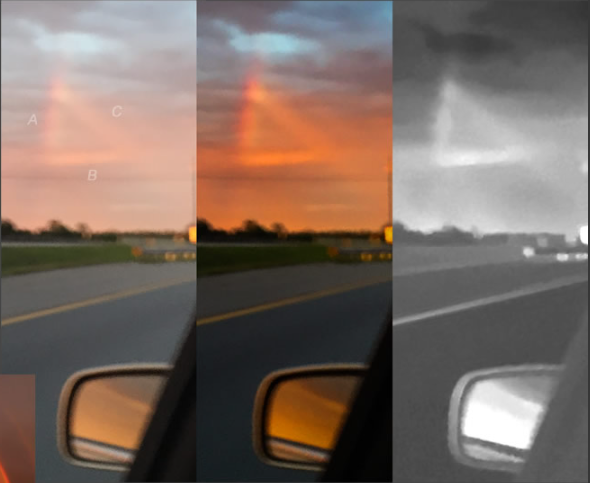
Side A has a strong red edge with weak greens on its right. It looks curved and extends weakly below and above the triangle.
The sky is brighter red on its inside (right) as expected from a sunset rainbow.
It is in the correct position relative to the sun for a rainbow.
Look how side C extends downwards and has a weaker red line above it.Sunset rainbows can be highly reddened. They light up the sky red inside the bow. This is key to what follows.
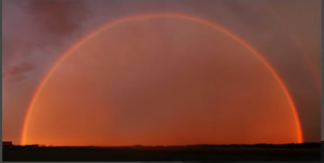 Image by Rafael Schmall
Image by Rafael Schmall
This image by Larry Phillips in Saskatchewan.
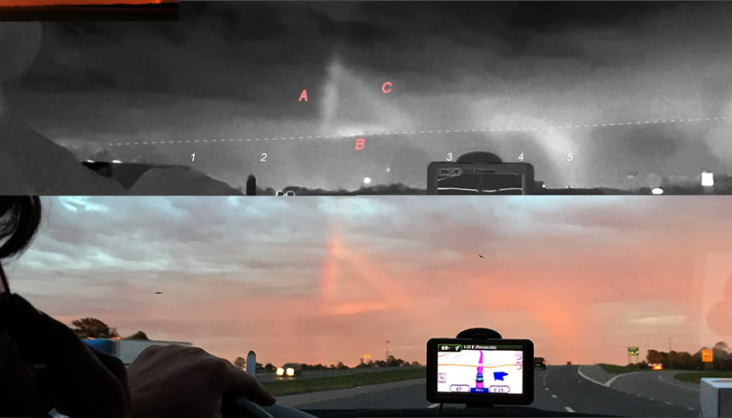
Side B
The topmost images show a red line parallel to the horizon extending well past the triangle to the left. This is very likely a cloud edge lit by the low sun. It brightens inside the rainbow as explained above.
Side C - The problem one!
Could it be a rainbows spoke or antisolar ray? No. Its angle to the rainbow's rim is wrong. A spoke or ray would lie along a radius of the rainbow arc.
What about reflections from water? No. Reflection bows do not form at that angle when the sun is almost on the horizon.
Could it be a streak of falling rain (virga or, alternatively, rain reaching the ground) strongly illuminated because it was just inside the rainbow? Strong evidence for this arrived when the image at right became available. Several slanting rain sheets, lit red by the low sun, are along the horizon. The upper part of this image was enhanced by colour subtraction to bring forth the red areas. Slanting rain is numbered 1 to 5.
But.. ..Was there rain? Was the wind in the right direction? Would the rainsheets be tilted at this angle?
We found the ground wind speed and direction from a local weather station and also obtained weather balloon measurements taken at different altitudes close to the time of the photos. There was rain and the wind was in the right direction.
Rain sheets tilt because the wind is slowed close to the ground and so falling rain drops get dragged back against the wind direction as they get lower.
We calculate the angle of the sheets as 40° after taking a raindrop diameter of 0.5mm estimated from the appearance of the rainbow fragment. This agrees reasonably with the tilt of ‘C’ and the other streaks.
The sheet making side C is so bright because the raindrops there are close inside the rainbow edge and reflect back strongly the sun's red light. The weaker line above side C is another rain streak.
Four separate and quite natural effects:
A reddened sunset sun
A rainbow fragment
An illuminated horizontal cloud bank
A rain sheet shining with rainbow rays
came coincidentally together to produce an eerie triangle in the sky.
Obvious in retrospect? Then so is most magic once explained!
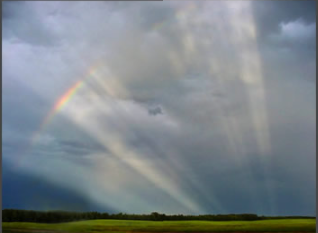
Rainbow spokes are always along radii. I.e. at right angles to the curve of the bow and passing through the bow centre.
Thanks to Viktor Golubic and Chris Isbert for alerting one of us and forwarding the images.The sighting was both fascinating and enigmatic. Three of us collaborated to get an explanation – Les Cowley (OPOD), Raymond Lee (US Naval Academy & co-author of Rainbow Bridge) and Gavin Pretor-Pinney (Author & founder of The Cloud Appreciation Society).
Note: this article has been automatically converted from the old site and may not appear as intended. You can find the original article here.
Reference Atmospheric Optics
If you use any of the definitions, information, or data presented on Atmospheric Optics, please copy the link or reference below to properly credit us as the reference source. Thank you!
-
<a href="https://atoptics.co.uk/blog/mississippi-triangle-a-sky-mystery-opod/">Mississippi Triangle, a sky mystery - OPOD</a>
-
"Mississippi Triangle, a sky mystery - OPOD". Atmospheric Optics. Accessed on April 30, 2024. https://atoptics.co.uk/blog/mississippi-triangle-a-sky-mystery-opod/.
-
"Mississippi Triangle, a sky mystery - OPOD". Atmospheric Optics, https://atoptics.co.uk/blog/mississippi-triangle-a-sky-mystery-opod/. Accessed 30 April, 2024
-
Mississippi Triangle, a sky mystery - OPOD. Atmospheric Optics. Retrieved from https://atoptics.co.uk/blog/mississippi-triangle-a-sky-mystery-opod/.